Development in nicotine product use among youtH

Image: Johnér
Development in nicotine product use among youtH
Cigarettes
In general, current cigarette smoking among youth in the Nordic and Baltic countries has been slowly declining from 2018 to 2024. In the following, the development in cigarette use among youth, overall and stratified by gender, is presented separately for the Nordic and Baltic countries. Only Norway, Sweden, and Lithuania had available data for 2024 by mid-December 2024.
Figure 1.1. Cigarette smoking in the Nordic countries

Sources: Studies underlying the presented data are described in detail under Presentation of data sources.
Figure 1.1. presents the development in cigarette smoking in the Nordic countries since 2018. Except for Norway, all included countries experienced an overall reduction in youth cigarette use. The latest data indicates that smoking prevalences among youth are highest in Norway (19% in 2024) and lowest in Iceland (6.6% in 2023).
Figure 1.2. Cigarette smoking in the Nordic countries, by gender
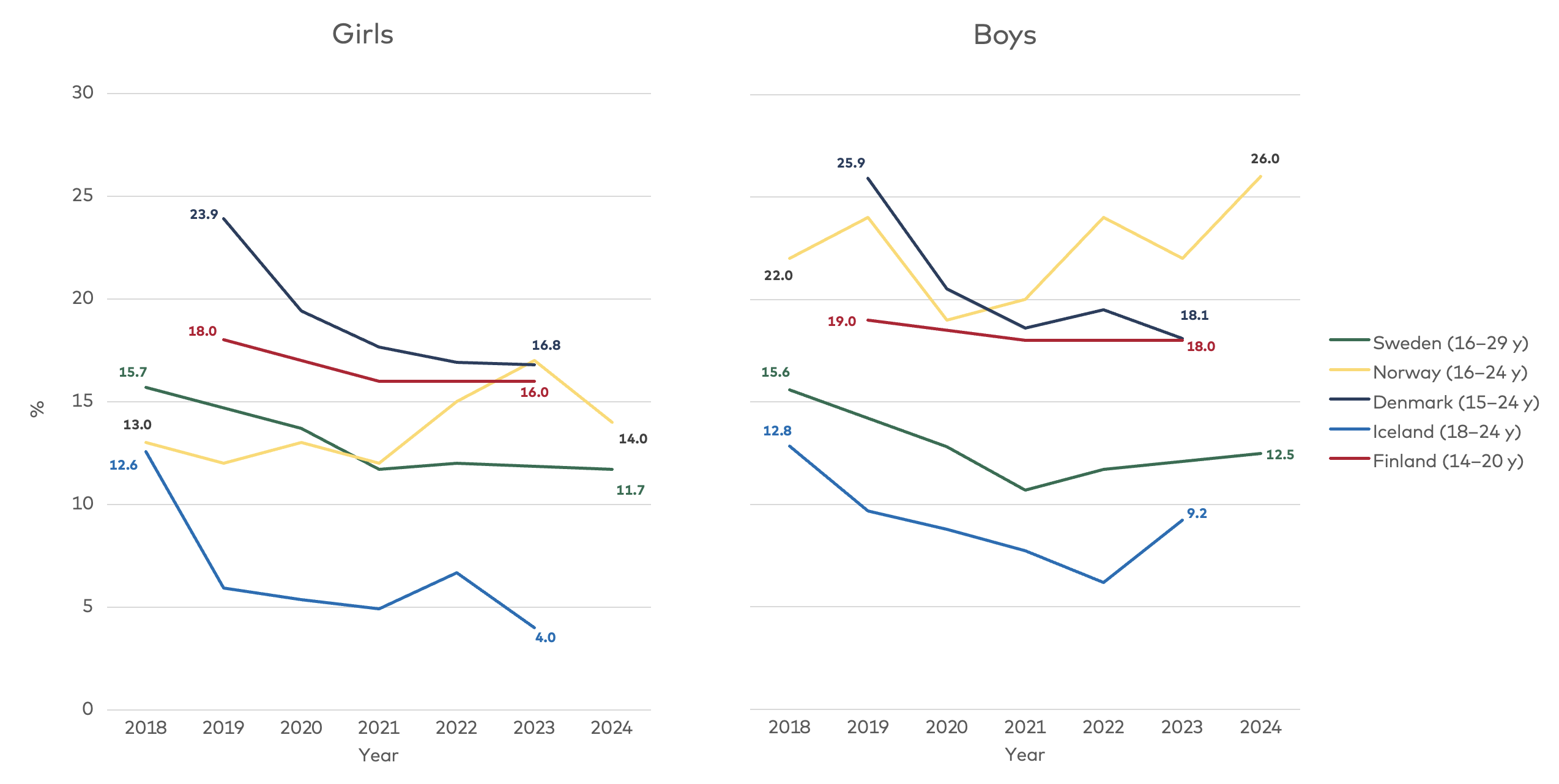
Sources: Studies underlying the presented data are described in detail under Presentation of data sources.
Figure 1.2. shows the development in prevalences for girls and boys separately in the Nordic region. In all the countries where cigarette use has decreased, the use has declined among both boys and girls. In Norway, the observed increase in cigarette use is most prominent among boys: from 22% in 2018 to 26% in 2024.
Figure 1.3. Cigarette smoking in the Baltic countries

Sources: Studies underlying the presented data are described in detail under Presentation of data sources.
Figure 1.3. presents the development in cigarette smoking in the Baltic countries. Smoking prevalences have decreased among Estonian and Lithuanian youth but have increased rapidly among Latvian youth. The most recent data available indicates that cigarette use is highest in Latvia (31.7% in 2022) and lowest in Lithuania (10.2% in 2024). However, this comparison needs to be qualified, as prevalences from 2024 were not yet available in Latvia and Estonia and the Lithuanian respondents (aged 15–16) are not the same age as the respondents (15–24) in Latvia and Estonia.
The gender-specific trends in cigarette use vary across the Baltic countries. Among Latvian youth, the increase in cigarette use appears more pronounced among boys than girls. In contrast, in Estonia, cigarette use seems to have risen among girls and declined among boys. In Lithuania, cigarette use is declining similarly among boys and girls (data not shown).
E-cigarettes
Since 2018, most of the Nordic and Baltic countries have seen a rapid increase in the use of e-cigarettes among youth. Particularly from 2021 and onwards, the prevalences have increased rapidly in most of the countries. In the following, the development in e-cigarette use among youth, overall and stratified on gender, is presented separately for the Nordic and Baltic countries. Only Norway, Sweden, and Lithuania had available data for 2024 by mid-December 2024.
Figure 2.1. E-cigarette use in the Nordic countries

Sources: Studies underlying the presented data are described in detail under Presentation of data sources.
Figure 2.1. shows the development in use of e-cigarettes among youth in the Nordic countries. All countries have experienced an increase in the use of e-cigarettes among youth, with a particularly rapid rise from 2021 and onwards. In Iceland, however, the pattern is slightly different, as prevalences have remained relatively consistently high throughout the period, without experiencing a further increase in 2021. The most recent available figures (either 2023 or 2024) show that the use of e-cigarettes is most prevalent among Finnish youth (16.0% in 2023) and least prevalent among Danish youth (8.7% in 2023).
Figure 2.2. E-cigarette use in the Nordic countries, by gender
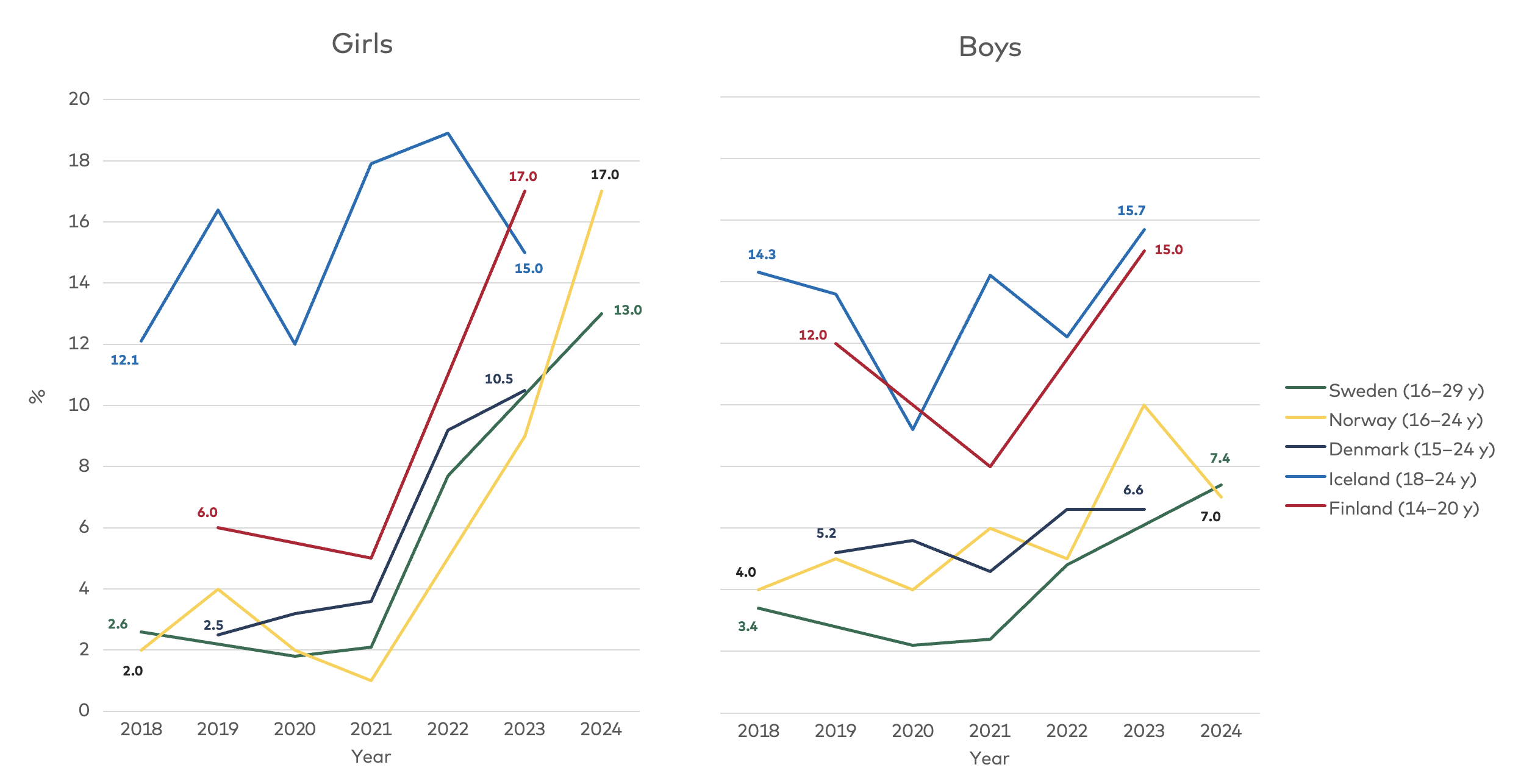
Sources: Studies underlying the presented data are described in detail under Presentation of data sources.
Figure 2.2. presents the development in prevalences separately for girls and boys in the Nordic region. The increase in use among youth in the Nordic countries is markedly more pronounced among girls than among boys. The increase in use from 2021, seen in all countries except for Iceland, is larger among girls than among boys. As a result, girls have now surpassed the boys in terms of use of e-cigarettes in all countries except Iceland. The difference between genders seems especially high in Norway, where the figure is 17% among girls compared to 7% among boys.
Figure 2.3. E-cigarette use in the Baltic countries
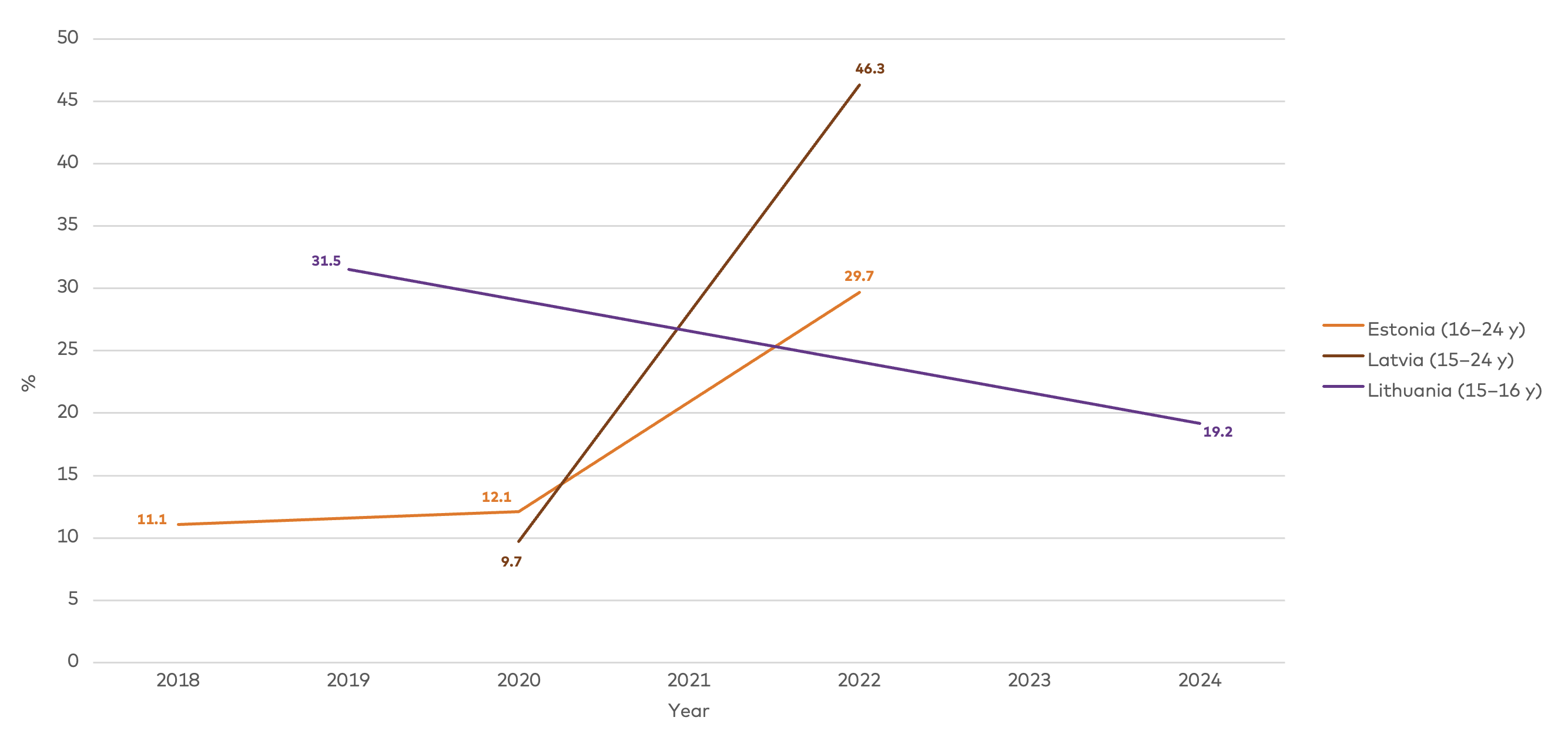
Sources: Studies underlying the presented data are described in detail under Presentation of data sources.
Figure 2.3. shows the development in e-cigarette use in the Baltic countries. The use of e-cigarettes has increased among Latvian and Estonian youth and decreased among Lithuanian youth. In 2022, the use of e-cigarettes was therefore most prevalent among Latvian youth (46.3%) and least prevalent among Lithuanian youth (20.6%). However, it should be noted that respondents in Lithuania were aged 15–16 as opposed to the 15–24-year-old respondents in Latvia and Estonia.
In Estonia, the observed increase in the use of e-cigarettes appears to be more pronounced among girls than boys. In contrast, in Latvia, the increase is more pronounced among boys than girls. In Lithuania, where a decrease in e-cigarette use is observed, the decline is more pronounced among boys than girls (data not shown).
Oral nicotine products
The use of oral nicotine products among youth has increased in most Nordic countries since 2018. Oral nicotine products cover both snus and nicotine pouches and, in some cases, also chewing tobacco (see table 1). In the following, the development in oral nicotine product use among youth, overall and stratified by gender, is presented separately for the Nordic and Baltic countries. Only Norway and Sweden had available data for 2024 by mid-December 2024.
Figure 3.1. Oral nicotine product use in the Nordic countries

Sources: Studies underlying the presented data are described in detail under Presentation of data sources.
Comments: Measures for Finland only included snus. This was also the case for Iceland until 2021, when nicotine pouches were included in the measure, and for Sweden until 2022, when nicotine pouches were explicitly included in the measure.
Comments: Measures for Finland only included snus. This was also the case for Iceland until 2021, when nicotine pouches were included in the measure, and for Sweden until 2022, when nicotine pouches were explicitly included in the measure.
Figure 3.1. presents the development in the use of oral nicotine products among youth in the Nordic countries. All countries, except for Finland, experienced an increase in the use of oral nicotine products. The most recent prevalences (either 2023 or 2024) indicate that the use of oral nicotine products is most prevalent among Icelandic youth (33.0%) and least prevalent among Finnish youth (9.0%). However, in Finland, this indicator covers only snus. Additionally, it should be noted that the significant increase among Icelandic youth seen from 2020 to 2021 coincides with the inclusion of nicotine pouches in the Icelandic measure of oral nicotine products.
Figure 3.2. Oral nicotine product use in the Nordic countries, by gender
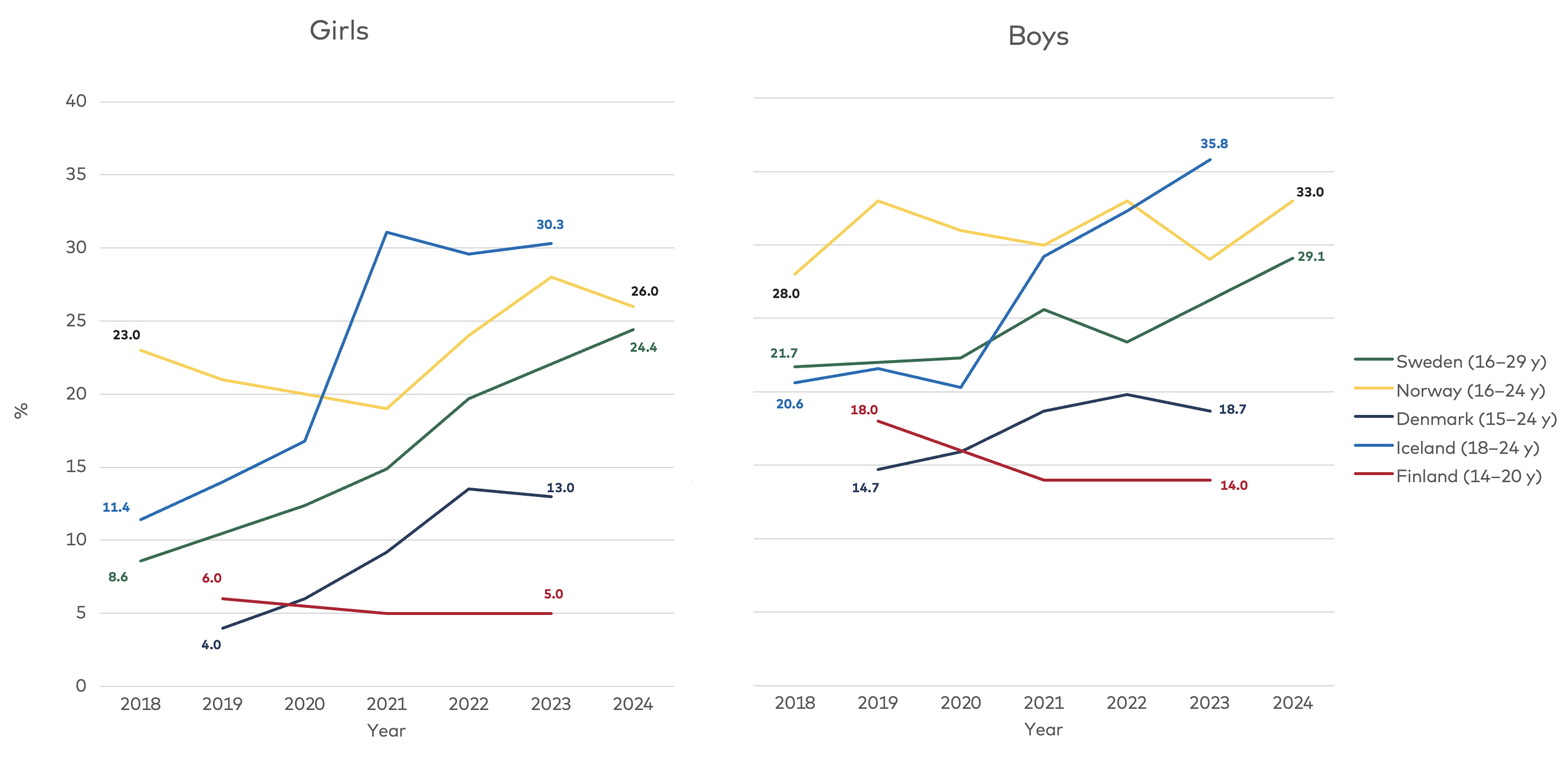
Sources: Studies underlying the presented data are described in detail under Presentation of data sources.
Comments: Measures for Finland only include snus. This was also the case for Iceland until 2021, when nicotine pouches were included in the measure, and for Sweden until 2022, when nicotine pouches were explicitly included in the measure.
Comments: Measures for Finland only include snus. This was also the case for Iceland until 2021, when nicotine pouches were included in the measure, and for Sweden until 2022, when nicotine pouches were explicitly included in the measure.
Figure 3.2. shows the development in prevalences separately for girls and boys in the Nordic region. Among the countries experiencing an increase in oral nicotine product use in the Nordic countries, the increase is more pronounced among girls than among boys. However, the use of oral nicotine products is still more prevalent among boys than girls in all the included countries.
Figure 3.3. Oral nicotine product use in the Baltic countries
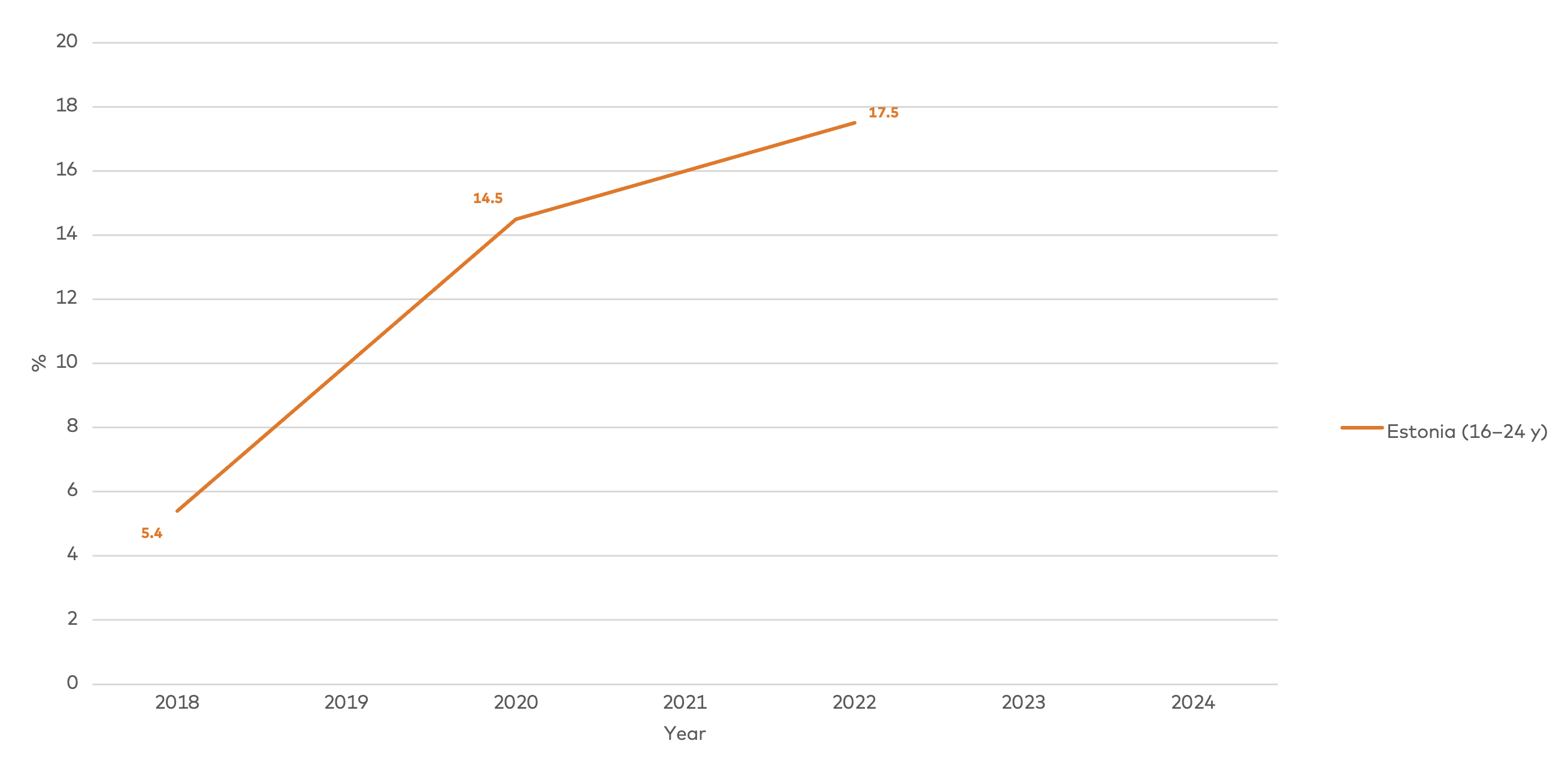
Sources: Studies underlying the presented data are described in detail under Presentation of data sources.
Figure 3.3. presents the development in the use of oral nicotine products among youth in Estonia since 2018. Due to lack of adequate data on daily and occasional use of oral nicotine products in Latvia and Lithuania, data on oral nicotine product use is not presented. In Estonia, the use of oral nicotine products has tripled since 2018. This increase is more pronounced among Estonian boys than girls (data not shown).